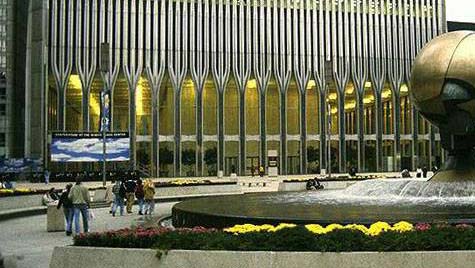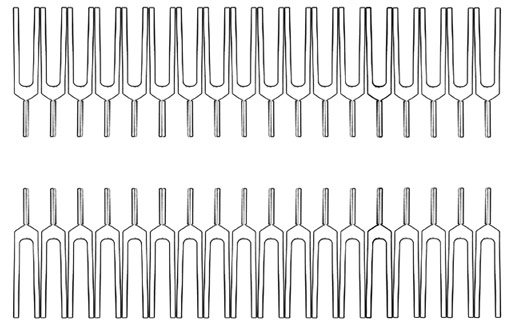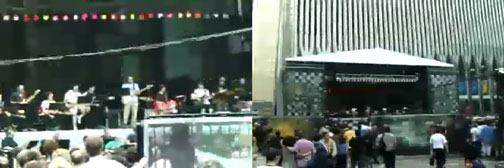
Music/Tuning/Mystory
Music
My mother and father were both classically trained musicians and they wanted
to pass these skills on to their children. To my father in particular, playing
classical music represented the fully rounded educated and successful person.
Science and academics were the rational "real" and music was its counterpart:
emotional expression. Both categories seemed to be envisioned by my father as
part of the order of things, as part of the ideal life, which he has always
projected that he is living. My mother, who was the more highly trained and
gifted musician, was cast as the awesome embodiment of female irrationality
and deep emotion, as the quintessential "otherness" of my father.
The respect and sublimation of this otherness, as well as many of the concepts
my father tried to impart, seemed to derive from the his deep roots in the humanist
tradition as it unfolded into the burgeoning field of science in the mid 20th
century.
Impossibility-incongruity
Every day my siblings and I were supposed to retreat to a sublime self-generated
world of "practicing" our instruments, a peculiar world of the crossing
of self-discipline and emotional expression. My instrument was the cello. Invariably
it began with the tuning process. The tuning fork was the preferred method.
To tune the A string the tuning fork was activated by striking it against a
hard object and then touching it to the instrument. Upon contact the note would
seem to emanate from deep within the instrument, or from everywhere. The tuning
then preceded sympathetically with played correct string. Other strings where
then tuned in harmonic fifths by ear.
Skill and Gift
Tuning was also connected to the notion of pitch, the learned process and gift
(or lack thereof) to "hear" a perfect note, to play in tune. A "good
ear" represented a high aptitude in this regard. "Perfect Pitch"
was applied to a rare few with amazing abilities to always hit the right note.
These aspects mirrored family notions of acquiring skill, becoming educated,
erudite, intelligent, and the ability to be persuasive conversationally. Practice
and work produced the basis and "talent" and "brilliance"
were

Transfer
The tuning fork was mysterious in that it transferred its sound to another object.
Even after it was struck, it put out very little sound until it contacted another
object. The sound, which resulted, seemed hard to locate, as if it came from
within the whole object.
Tuning the Body
I remember discovering that touching the tuning fork to the head caused the
note emanate from inside the head. Touching the fork to the tongue produced
an unbearably intense sensation of tickling and burning. These gestures relate
to a lifetime interest in the problematics of mind and body, as well as an act
of resistance, disorder.
See Pythagoras as the blender
of science and music:
Double parentheses are mine.
“Pythagoras (6th C. B.C.) observed that when the blacksmith struck his
anvil, different notes were produced according to the weight of the hammer.
Number (in this case "amount of weight") seemed to govern musical
tone. . . . .
If you have something like SoundMachine that can play sound (.av), you can pluck
the strings to hear the notes: the sounds may take some seconds to reach you
but each is under 22K....See if you can hear the sound in your imagination before
it comes, by judging from the proportions of the string lengths (the first one's
easy.....)
Further, he observed that if you take two strings in the same degree of tension,
and then divide one of them exactly in half, when they are plucked the pitch
of the shorter string is exactly one octave higher than the longer:
Again, number (in this case "amount of space") seemed to govern musical
tone. Or does musical tone govern number?
He also discovered that if the length of the two strings are in relation to
each other 2:3, the difference in pitch is called a fifth:
...and if the length of the strings are in relation to each other 3:4, then
the difference is called a fourth.
Thus the musical notation of the Greeks, which we have inherited can be expressed
mathematically as 1:2:3:4
All this above can be summarised in the following.
(Another consonance which the Greeks recognised was the octave plus a fifth,
where 9:18 = 1:2, an octave, and 18:27 = 2:3, a fifth;)
This triangular figure of numbers in the shape of the Greek letter Lamda ((an
upside down Y)) is the Tetrad of the Pythagorians. As was discussed by Plato
in his dissertation on the Composition of the Soul, it is a set of numbers whose
relationships with each other seemed to summarize all the inter-dependent harmonies
within the universe of space and time.
Thus to have established the relationship between music and space/number fired
the imagination of the Pythagorians and was taken up especially by the School
of Plato and the subsequent Neo-Platonists. Pythagoras himself wrote nothing
which has survived, and so it is the Platonists we have to thank for recording
and developing what had hitherto been passed down through two hundred and fifty
years of oral tradition. ((Note: the secrecy tradition!))
Pythagoras taught that each of the seven planets produced by its orbit a particular
note according to its distance from the still centre which was the Earth. The
distance in each case was like the subdivisions of the string refered to above.
This is what was called Musica Mundana, which is usually translated as Music
of the Spheres. The sound produced is so exquisite and rarified that our ordinary
ears are unable to hear it. It is the Cosmic Music which, according to Philo
of Alexandria, Moses had heard when he recieved the Tablets on Mount Sinai,
and which St Augustine believed men hear on the point of death, revealing to
them the highest reality of the Cosmos. (Carlo Bertelli, Piero della Francesca,
p. 60.) This music is present everywhere and governs all temporal cycles, such
as the seasons, biological cycles, and all the rhythms of nature. Together with
its underlying mathematical laws of proportion it is the sound of the harmony
of the created being of the universe, the harmony of what Plato called the "one
visible living being, containing within itself all living beings of the same
natural order".
For the Pythagorians different musical modes have different effects on the person
who hears them; Pythagoras once cured a youth of his drunkenness by prescribing
a melody in the Hypophrygian mode in spondaic rhythm. Apparently the Phrygian
mode would have had the opposite effect and would have overexcited him. At the
healing centers of Asclepieion at Pergamum and Epidauros in Greece, patients
underwent therapy accompanied by music. The Roman statesman, philosopher and
mathematician, Boethius (480-524 A.D.) explained that the soul and the body
are subject to the same laws of proportion that govern music and the cosmos
itself. We are happiest when we conform to these laws because "we love
similarity, but hate and resent dissimilarity". (De Institutione Musica,
1,1. from Umberto Eco, Art and Beauty in the Middle Ages. p. 31).”
In a message dated 4/13/02 12:45:20 PM, rmoss@RAREDEVICE.COM
writes:
Re: Soft Wishing Y Memorial Space
<< Slate had an article a while back about how Yamasaki was influenced
by
Islamic architecture in the design of the WTC, mentioning in particular
these arch-like (and tuning-fork like) features.
http://slate.msn.com/?id=2060207
-Becki >>


In a message dated 4/15/03 10:26 AM, Willpap writes:
Re: Uncanny Soft Wishing Y Memorial Space
<<Becki,
I must thank you for your reference MSN's Slate (http://slate.msn.com/?id=2060207).
Last night it led me down the most important digital dousing path to date. The
article on Islamic correspondances/influences of Japanese architect Yamasaki
in designing the WTCs as a plaza similar to Mecca, with 2 Minarets, is nothing
less than stunning and in all likelihood one of the reasons for Bin Laden's
focus on base buildings.
Together with the suggestion you also made of associating the pointed Arches
with tuning forks and Ys, I set out through looking at my own area video footage
of the Trade Towers both before and after the attacks, and of course set off
virtually through the Internet to look at Islamic architecture.
As you'll see once I set up some imagery and pages to deal with this issue,
the resemblance of the WTCs and many of the important religious and palace sites
of the Middle East is undeniable. In particular I found a fascinating tomb in
Iran called Monar-e-Jonban or The Shaking Minarets. In this landmark two minarets
flank a central wishbone shaped arch. The reason they are thought of as "shaking"
is that the geometry of the architecture is such that if one walks up one tower
the other one shakes identically. A veritable tuning fork. So powerful was is
shaking that a couple of these mosques have lost two-thirds of their Minarets.
The British, as colonial powers, were often rumored to be responsible for this
problem.
This pair of tombs, WTCs and Monar-e-Jonban so uncannily suggests the relationships
between currently opposing cultures. And shows how reflecting the one is (always)
in the other.
A colleague has also pointed out to me that the change from a Romanesque arch
to the Gothic arch was generated by Western contact with the Middle east. Ultimately,
the Gothic arch allowed for increased height of architectural structures, and
hence ultimately the skyscraper.
One more interesting events/phenomena gets added to this mix. Last summer I
had the wonderful privilege of seeing/hearing the concert debut of a piece by
avant-garde guitar artist Glenn Branca performed in the plaza between the two
Trade Centers. It was called Symphony #No. 13, Hallucination City and consisted,
as he is well known for, of a piece for 100 electric guitars. The sound created
by these many different guitarists playing the same chords, itself like the
mechanism of the tuning fork, rose and resonated to engulf the entire plaza
beneath the towers, as if for a moment they were transformed from Commerce to
Music, as Greg suggested, at giant turning fork. I made a short video of this
experience this past fall as part of a post 9/11 memorial project with my video
class. Now of course, it is taken on another overtone. (I will include it as
part of the Website.) The tuning fork, in its shape and in it this generative
power, I now realize takes hold within these images for me because it was the
mysterious instrument with which I tuned my cello as as a child.
What more can I say, Becki, but the sincerest thanks for your catalyst participation
in this project. and now back to work.
Will Pappenheimer (Pomer)>>

Glenn Branca, Premiere of Symphony #13, Hallucination City
LMCC, June 13, 2001
In a message dated 4/15/02 9:50:07 AM, gulmer@ENGLISH.UFL.EDU
writes:
Re: Uncanny Soft Wishing Y Memorial Space
<< On Sun, 14 Apr 2002, Will Pappenheimer wrote:
> (I will include it as part of the Website.) The tuning fork, in its shape
and
> in it this generative power, I now realize takes hold within these images
for
> me because it was the mysterious instrument with which I tuned my cello
as as
> a child.
>
Once embarked on the inference path of conduction the uncanniness
increases exponentially (holistic category formation). The tuning fork
emerges now as the "sinthome" (Lacan)--the circulating prop--of your
mystory. It would be good to include an anecdote on the website,
expressing some "obtuse" (Barthes) memory involving the tuning fork.
as for our collaboration
I found my prop in the memory of a piano lesson: the sticky stars
glued to the sheet music by my teacher rating how well I had learned the
piece (gold, silver, red). This star resonated with the tin star in Hign
Noon, and the stars on Custers shoulder's in a photograph of him at the
end of the Civil War (youngest general in the Union army).
Reading now about XML, I have discovered a further significance of
"star"...
glue >>
"On clear evenings, not far
from where I now
reside in Brooklyn, a third tower, mirrored below
the water was visible at sunset."
..and
if the length of the strings are in
relation
to each other 3:4, then the
difference is called a fourth.
In a message dated 4/12/02 11:40:43 AM, gulmer@ENGLISH.UFL.EDU
writes:
Re: Soft Wishing Y Memorial Space
<< Hi Will & wishers
I like the collection of the Y eidos you are assembling on the
website. The tuning fork is a nice addition. Perhaps you or some
recruit (Tilson?) could do/simulate/modify a basic design drawing of the
Twin Towers to show that they were the prongs of a tuningskysraper fork.
The divination method in any case expresses a cosmology of
correspondences (Pythagorean 'as above so below'), hence "the music of
the spheres." >>
In a message dated 4/13/02 1:28 PM, Willpap writes:
Re- Soft Wishing Y Memorial Sp
<<"There is geometry in the humming
of the strings." Tuning octaves, splitting strings in two>>
Sympathetic adj.
1. Of, expressing, feeling, or resulting from sympathy.
2. Favorably inclined.
3. Agreeably suited to one's disposition or mood; congenial.
4. Of, relating to, or acting on the sympathetic nervous system.
5.a. Relating to or being vibrations, especially
musical tones, produced in
one body by energy from a nearby vibrating body and having the same
frequency as the vibration of the nearby body. b. Emitting such vibrations.
Monar-e-Jonban
The Shaking Minarets
"The eivan and porch were probably erected shortly after 1316 to cover
the grave of Amu Abdollah Soqla, a hermit, who was buried here. The minarets
are of later, probably Safavid, origin, and are largely responsible for the
fame of the otherwise unremarkable shrine. The roof above the shrine contains
some good, but unremarkable brickwork.
Because of the ratio between the height and width of the minarets
and the width of the eivan, if you climb into one minaret and shake it, the
other will shake in unison. This constant shaking has been responsible for considerable
structural damage, although this is locally blamed on British interference!
You can experiment with the phenomenon on this site by clicking on the left
minaret in the image above while will make the right one shake - although rather
more than the real ones do!
There is another pair of shaking minarets built during the time
of Oljeitu, at Oshtorjan, although these have lost the upper two thirds.
The wooden beams on the upper part of the minarets have been placed there to facilitate the shaking of the minarets, but the presence of wood in the brickwork causes other complications. Shaking is in theory restricted to once every twenty minutes, however, particularly during holidays, there is a constant stream of visitors who experiment with the phenomenon, and the visitor will have ample chance to observe it from ground level, without running the risk of being blamed for any further dereliction. According to Honarfar, the porch is 10 metres high and 10 metres in width, the minarets are 7 metres taller and are 4 metres in circumference."